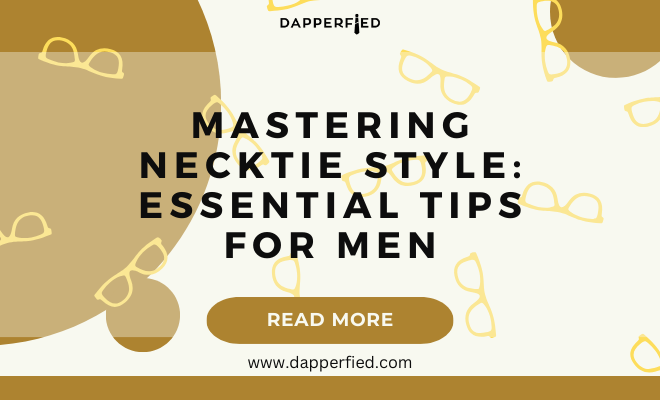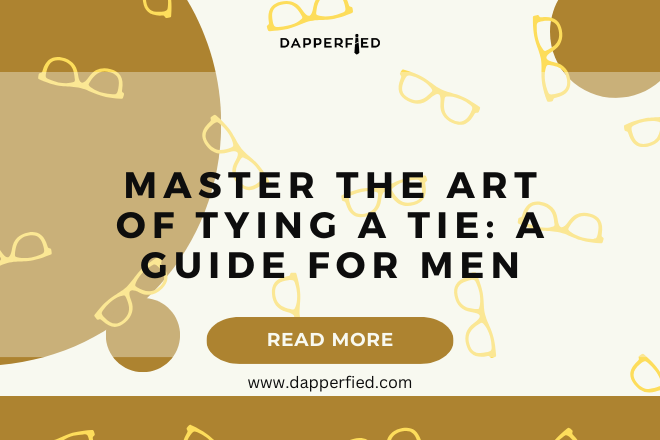
Men's Style
Mastering Necktie Style: Essential Tips for Men
When it comes to choosing the right tie for any occasion, it’s important to consider the formality of the event. For formal events such as weddings, black-tie galas, or business meetings, a silk tie in a solid color or subtle pattern is a safe and classic choice. For more casual events, such as a night out with friends or a weekend brunch, you can opt for a more playful and colorful tie with bold patterns or textures. It’s also important to consider the season and time of day when choosing a tie. In the spring and summer, lighter colors and fabrics such as linen or cotton are more appropriate, while in the fall and winter, darker colors and heavier fabrics like wool or cashmere are more suitable. Ultimately, the key to choosing the right tie for any occasion is to strike a balance between personal style and appropriateness for the event.
When selecting a tie, it’s also important to consider the color and pattern of your shirt and suit. A tie should complement your outfit rather than clash with it. For example, if you’re wearing a patterned shirt, it’s best to choose a solid color tie that complements one of the colors in the shirt. If your suit is a solid color, you have more freedom to experiment with different patterns and textures in your tie. Additionally, consider the color of your skin and hair when choosing a tie. Certain colors may complement your complexion better than others, so it’s important to take this into account when making your selection. Overall, choosing the right tie for any occasion requires careful consideration of the formality of the event, the season and time of day, and how the tie will complement your overall outfit.
Key Takeaways
- Consider the occasion and dress code when choosing a tie
- Learn different knots and how to tie them for various looks
- Coordinate tie patterns and textures with shirts and suits
- Ensure the proper length and width of your tie for a polished look
- Take care of your ties to maintain their quality and appearance
- Express personal style through tie accessories like tie bars and pocket squares
Understanding Different Knots and How to Tie Them
There are several different knots that can be used to tie a necktie, each with its own unique look and level of difficulty. The most common knot is the four-in-hand knot, which is simple to tie and creates a small, asymmetrical knot. This knot is suitable for most occasions and works well with both wide and narrow collars. The half-Windsor knot is slightly larger and more symmetrical than the four-in-hand knot, making it a good choice for business meetings or formal events. The full Windsor knot is the largest and most formal of the knots, making it ideal for special occasions such as weddings or black-tie events. It’s important to choose a knot that complements the width of your collar and the formality of the event. Additionally, it’s essential to practice tying different knots to ensure that you can achieve a neat and symmetrical look every time.
In addition to the traditional knots, there are also more unique and complex knots that can add a touch of personality to your outfit. The Eldredge knot, for example, is a complex knot that creates an intricate woven look and is sure to make a statement. The Trinity knot is another eye-catching option that features three interwoven sections for a distinctive look. While these knots may be more challenging to tie, they can add an extra element of style to your outfit. Ultimately, understanding different knots and how to tie them allows you to choose the best knot for the occasion and express your personal style through your necktie.
Matching Ties with Shirts and Suits
Matching ties with shirts and suits is an essential skill for creating a polished and put-together look. When it comes to matching ties with shirts, it’s important to consider both color and pattern. If you’re wearing a solid color shirt, you have more freedom to experiment with different patterns and textures in your tie. However, if your shirt has a pattern, it’s best to choose a tie in a complementary color that doesn’t clash with the shirt. For example, if you’re wearing a striped shirt, you can choose a tie with a subtle pattern or solid color that complements one of the colors in the shirt. When matching ties with suits, it’s important to consider both the color and fabric of the suit. A solid color suit allows for more flexibility in choosing a tie, while a patterned suit requires a more subtle and complementary tie.
In addition to color and pattern, it’s also important to consider the width of your tie in relation to the width of your suit lapels. A general rule of thumb is that the width of your tie should match the width of your suit lapels. For example, if you’re wearing a suit with narrow lapels, a skinny tie is more appropriate, while a wider tie complements suits with wider lapels. Ultimately, matching ties with shirts and suits requires careful consideration of color, pattern, fabric, and width to create a cohesive and stylish look.
Incorporating Patterns and Textures into Your Necktie Style
| Patterns and Textures | Benefits |
|---|---|
| Striped Necktie | Classic and professional look |
| Polka Dot Necktie | Playful and stylish appearance |
| Knit Necktie | Textured and casual vibe |
| Plaid Necktie | Rustic and traditional feel |
Incorporating patterns and textures into your necktie style is a great way to add visual interest and personality to your outfit. When it comes to patterns, there are several classic options to choose from, including stripes, polka dots, plaids, and paisleys. Striped ties are versatile and can be worn for both formal and casual occasions, while polka dot ties add a playful touch to any outfit. Plaid ties are perfect for adding a pop of color and texture to a solid color shirt or suit, while paisley ties offer a more intricate and sophisticated look. It’s important to consider the scale of the pattern in relation to the scale of your shirt or suit. For example, if you’re wearing a shirt with a small-scale pattern, it’s best to choose a tie with a larger-scale pattern to create contrast.
In addition to patterns, textures can also add depth and dimension to your necktie style. Fabrics such as silk, wool, linen, and cotton each have their own unique texture and drape, allowing you to create different looks for different occasions. For formal events, silk ties with a smooth and lustrous texture are ideal, while for more casual events, textured ties such as wool or linen add a relaxed and effortless touch. Ultimately, incorporating patterns and textures into your necktie style allows you to express your personal style and create visually dynamic outfits.
Proper Length and Width of a Necktie
The proper length and width of a necktie are essential for achieving a polished and well-proportioned look. The standard length for a necktie is around 57-58 inches, which should allow you to tie a neat knot without the tie ending up too short or too long. If you’re particularly tall or have a larger neck size, you may need an extra-long tie to ensure that it reaches the appropriate length. On the other hand, if you’re on the shorter side or have a smaller neck size, you may need a shorter tie to avoid excess length hanging down past your waistline. It’s important to take your body proportions into account when choosing the length of your tie to ensure that it looks balanced with your outfit.
In terms of width, the standard width for a necktie is around 3-3.5 inches at its widest point. This width is considered versatile and suitable for most body types and suit lapel widths. However, if you have a slim build or are wearing a suit with narrow lapels, a skinny tie with a width of around 2-2.5 inches may be more appropriate. On the other hand, if you have a broader build or are wearing a suit with wider lapels, a wider tie with a width of around 3.5-4 inches may be more suitable. Ultimately, choosing the proper length and width of a necktie ensures that it complements your body proportions and creates a harmonious look with your outfit.
Caring for and Maintaining Your Necktie Collection

Caring for and maintaining your necktie collection is essential for preserving their quality and longevity. When it comes to storage, it’s best to hang your ties on a tie rack or hanger to prevent wrinkles and creases from forming. Avoid hanging them on sharp edges or hooks that could damage the fabric. If you need to travel with your ties, roll them up rather than folding them to prevent creases from setting in. When it comes to cleaning, spot clean any stains on your ties immediately using a gentle fabric cleaner or by blotting with water. Avoid machine washing or dry cleaning your ties unless absolutely necessary, as these methods can damage delicate fabrics such as silk.
To maintain the shape of your ties, untie them carefully after each wear rather than pulling them off over your head. This will prevent wrinkles from forming at the knot and help them retain their shape over time. Additionally, consider rotating your ties regularly to prevent excessive wear on any one tie. If you notice any loose threads or snags on your ties, take them to a professional tailor for repair rather than attempting to fix them yourself. Ultimately, caring for and maintaining your necktie collection ensures that they remain in pristine condition for years to come.
Expressing Personal Style Through Necktie Accessories
Expressing personal style through necktie accessories is an opportunity to add unique touches to your outfit. One popular accessory is the tie bar or tie clip, which not only adds visual interest but also keeps your tie in place throughout the day. When choosing a tie bar or clip, consider the width of your tie and ensure that it complements rather than overwhelms the tie. Another accessory option is the pocket square, which can be coordinated with your tie for a cohesive look or chosen in a contrasting color or pattern for added visual interest.
In addition to traditional accessories, there are also more unconventional options for expressing personal style through neckties. Lapel pins or brooches can add an unexpected touch of flair to your outfit when coordinated with your tie or pocket square. Another option is novelty cufflinks featuring playful designs or motifs that reflect your interests or hobbies. Ultimately, expressing personal style through necktie accessories allows you to add unique touches to your outfit and showcase your individuality in any setting.

In conclusion, choosing the right tie for any occasion requires careful consideration of formality, seasonality, and personal style preferences. Understanding different knots allows you to choose the best knot for each occasion while matching ties with shirts and suits ensures that your outfit looks cohesive and well put-together. Incorporating patterns and textures into your necktie style adds visual interest and depth while choosing the proper length and width ensures that your tie complements your body proportions and outfit. Caring for and maintaining your necktie collection preserves their quality over time while expressing personal style through necktie accessories allows you to add unique touches to your outfit that reflect your individuality.
If you’re looking for more style tips for men, be sure to check out Dapperfied’s article on modern men’s suits for a quick refresher. Whether you’re a young professional or just want to update your wardrobe, this article offers great advice on how to choose the right suit for any occasion. Check it out here!
FAQs
What are some popular necktie styles for men?
Some popular necktie styles for men include the classic silk tie, the skinny tie, the bow tie, and the knit tie.
How should a necktie be tied?
A necktie should be tied with a proper knot, such as the Windsor knot, the half-Windsor knot, or the four-in-hand knot, to ensure a polished and professional look.
What are some tips for choosing the right necktie for an outfit?
When choosing a necktie for an outfit, consider the color, pattern, and fabric of the tie to complement the shirt and suit. It’s also important to consider the occasion and the overall style you want to achieve.
How should a necktie be worn?
A necktie should be worn at the appropriate length, typically reaching the belt buckle. It should be properly knotted and secured with a tie clip or bar if desired.
What are some common mistakes to avoid when wearing a necktie?
Common mistakes to avoid when wearing a necktie include wearing a tie that is too long or too short, choosing a tie that clashes with the outfit, and tying the knot improperly. It’s also important to ensure that the tie is properly ironed and free of wrinkles.














